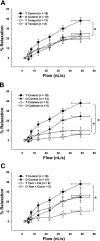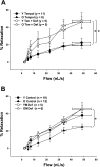Aging impairs flow-induced dilation in coronary arterioles: role of NO and H(2)O(2)
- PMID: 19617414
- PMCID: PMC2755981
- DOI: 10.1152/ajpheart.00356.2009
Aging impairs flow-induced dilation in coronary arterioles: role of NO and H(2)O(2)
Abstract
Aging contributes significantly to the development of cardiovascular disease and is associated with elevated production of reactive oxygen species (ROS). The beneficial effects of nitric oxide (NO)-mediated vasodilation are quickly abolished in the presence of ROS, and this effect may be augmented with aging. We previously demonstrated an age-induced impairment of flow-induced dilation in rat coronary arterioles. Therefore, the purpose of this study was to determine the effects of O(2)(-) scavenging, as well as removal of H(2)O(2), the byproduct of O(2)(-) scavenging, on flow-mediated dilation in coronary resistance arterioles of young (4 mo) and old (24 mo) male Fischer 344 rats. Flow increased NO and H(2)O(2) production as evidenced by enhanced diaminofluorescein and dichlorodihydrofluorescein fluorescence, respectively, whereas aging reduced flow-induced NO and H(2)O(2) production. Endothelium-dependent vasodilation was evaluated by increasing intraluminal flow (5-60 nl/s) before and after treatment with the superoxide dismutase mimetic Tempol (100 muM), the H(2)O(2) scavenger catalase (100 U/ml), or Tempol plus catalase. Catalase reduced flow-induced dilation in both groups, whereas Tempol and Tempol plus catalase diminished vasodilation in young but not old rats. Tempol plus deferoxamine (100 muM), an inhibitor of hydroxyl radical formation, reversed Tempol-mediated impairment of flow-induced vasodilation in young rats and improved flow-induced vasodilation in old rats compared with control. Immunoblot analysis revealed increases in endogenous superoxide dismutase, catalase, and nitrotyrosine protein levels with aging. Collectively, these data indicate that NO- and H(2)O(2)-mediated flow-induced signaling decline with age in coronary arterioles and that elevated hydroxyl radical formation contributes to the age-related impairment of flow-induced vasodilation.
Figures









Similar articles
-
Aging and estrogen alter endothelial reactivity to reactive oxygen species in coronary arterioles.Am J Physiol Heart Circ Physiol. 2011 Jun;300(6):H2105-15. doi: 10.1152/ajpheart.00349.2010. Epub 2011 Mar 25. Am J Physiol Heart Circ Physiol. 2011. PMID: 21441309 Free PMC article.
-
Effects of ageing and exercise training on eNOS uncoupling in skeletal muscle resistance arterioles.J Physiol. 2009 Aug 1;587(Pt 15):3885-97. doi: 10.1113/jphysiol.2009.172221. Epub 2009 Jun 15. J Physiol. 2009. PMID: 19528246 Free PMC article.
-
Age and exercise training alter signaling through reactive oxygen species in the endothelium of skeletal muscle arterioles.J Appl Physiol (1985). 2013 Mar 1;114(5):681-93. doi: 10.1152/japplphysiol.00341.2012. Epub 2013 Jan 3. J Appl Physiol (1985). 2013. PMID: 23288555 Free PMC article.
-
The effect of tempol on endothelium-dependent vasodilatation and blood pressure.Pharmacol Ther. 2009 May;122(2):109-24. doi: 10.1016/j.pharmthera.2009.02.002. Epub 2009 Mar 5. Pharmacol Ther. 2009. PMID: 19268689 Review.
-
Redox balance in the aging microcirculation: new friends, new foes, and new clinical directions.Microcirculation. 2012 Jan;19(1):19-28. doi: 10.1111/j.1549-8719.2011.00139.x. Microcirculation. 2012. PMID: 21954960 Free PMC article. Review.
Cited by
-
Aging impairs electrical conduction along endothelium of resistance arteries through enhanced Ca2+-activated K+ channel activation.Arterioscler Thromb Vasc Biol. 2013 Aug;33(8):1892-901. doi: 10.1161/ATVBAHA.113.301514. Epub 2013 May 30. Arterioscler Thromb Vasc Biol. 2013. PMID: 23723370 Free PMC article.
-
Mechanical ventilation reduces rat diaphragm blood flow and impairs oxygen delivery and uptake.Crit Care Med. 2012 Oct;40(10):2858-66. doi: 10.1097/CCM.0b013e31825b933a. Crit Care Med. 2012. PMID: 22846782 Free PMC article.
-
Changes in eNOS phosphorylation contribute to increased arteriolar NO release during juvenile growth.Am J Physiol Heart Circ Physiol. 2012 Feb 1;302(3):H560-6. doi: 10.1152/ajpheart.00277.2011. Epub 2011 Dec 2. Am J Physiol Heart Circ Physiol. 2012. PMID: 22140037 Free PMC article.
-
Caloric restriction: powerful protection for the aging heart and vasculature.Am J Physiol Heart Circ Physiol. 2011 Oct;301(4):H1205-19. doi: 10.1152/ajpheart.00685.2011. Epub 2011 Aug 12. Am J Physiol Heart Circ Physiol. 2011. PMID: 21841020 Free PMC article.
-
Effects of high-intensity interval training on cardiac remodelling, function and coronary microcirculation in de novo heart transplant patients: a substudy of the HITTS randomised controlled trial.BMJ Open Sport Exerc Med. 2023 Jul 9;9(3):e001331. doi: 10.1136/bmjsem-2022-001331. eCollection 2023. BMJ Open Sport Exerc Med. 2023. PMID: 37440977 Free PMC article.
References
-
- Blackwell KA, Sorenson JP, Richardson DM, Smith LA, Suda O, Nath K, Katusic ZS. Mechanisms of aging-induced impairment of endothelium-dependent relaxation: role of tetrahydrobiopterin. Am J Physiol Heart Circ Physiol 287: H2448–H2453, 2004. - PubMed
-
- Bulvik B, Grinberg L, Eliashar R, Berenshtein E, Chevion MM. Iron, ferritin and proteins of the methionine-centered redox cycle in young and old rat hearts. Mech Ageing Dev 130: 139–144, 2009. - PubMed
-
- Carroll RT, Galatsis P, Borosky S, Kopec KK, Kumar V, Althaus JS, Hall ED. 4-Hydroxy-2,2,6,6-tetramethylpiperidine-1-oxyl (Tempol) inhibits peroxynitrite-mediated phenol nitration. Chem Res Toxicol 13: 294–300, 2000. - PubMed
-
- Celermajer DS, Sorensen KE, Spiegelhalter DJ, Georgakopoulos D, Robinson J, Deanfield JE. Aging is associated with endothelial dysfunction in healthy men years before the age-related decline in women. J Am Coll Cardiol 24: 471–476, 1994. - PubMed
-
- Chilian WM, Eastham CL, Marcus ML. Microvascular distribution of coronary vascular resistance in beating left ventricle. Am J Physiol Heart Circ Physiol 251: H779–H788, 1986. - PubMed
Publication types
MeSH terms
Substances
Grants and funding
LinkOut - more resources
Full Text Sources
Medical

